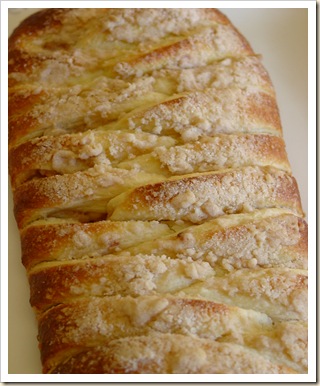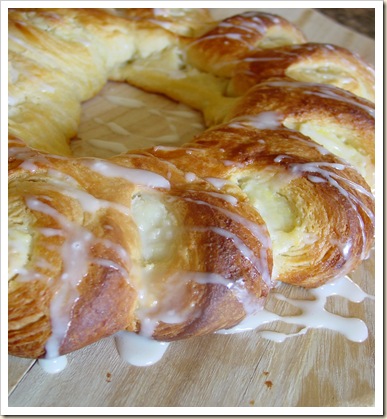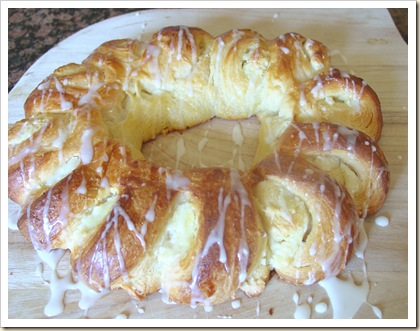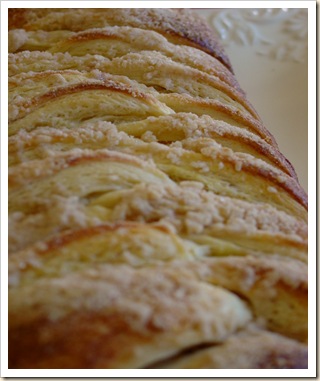Yep, it's that time of the month again. Time for another Daring Baker's challenge. When I looked at the challenge this month, I was so excited. I had never made a laminate dough before but had been wanting to for awhile. Leave it up to the Daring Baker's to make it happen sooner rather than later. This months challenge was Danish pastry.
The Danish pastry dough is a mix between a yeasty sweet dough and a puff pastry. The sweet yeast dough is rolled out and spread with a mixture of butter and flour. Then it is folded into thirds and refrigerated. The rolling and folding is repeated 3 more times and then the dough must rest in the refrigerator for several hours. This process creates thin layers of butter all throughout the dough which result in that deliciously light and flaky pastry. The dough usually contains cardamom and orange both of which I left out. I substituted extra milk for the orange juice and added some almond extract to the dough for extra flavor.
We were given a choice of fillings and it was so hard to pick. First I made a ring shaped pastry filled with a mixture of homemade almond paste, cream cheese and powdered sugar. I then topped the ring with a lemony powdered sugar glaze. This one was so delicious. The pastry was flaky just as I had hoped it would be and the filling was absolutely delicious. I really liked the tang that the lemon and powdered sugar glaze gave, it really helped to balance all of the other sweet flavors.
For my second pastry I made the traditional braid shape and filled it with a light layer of the almond and cream cheese mixture followed by some cinnamon apples. I then topped the braid with a crumb topping. The smell as it baked was heavenly, you could smell the yeast dough with hints of cinnamon. If the smell was good, the taste was even better. The almond mixture puffed up slightly and mixed with the cinnamon apples and the dough was perfectly flaky and buttery. I can't believe that I've never made this before. It was surprisingly easy and may only be thought as difficult due to the time involved in making it, most of which is the dough resting.
If you want to be daring too, give this on a try, it was delicious. Check out what all of the other Daring Bakers have made. A big thanks to Kelly of Sass & Veracity and Ben from What's Cookin'? for hosting this wonderful challenge. It was a lot of fun and delicious to boot.
DANISH DOUGH

Makes 2-1/2 pounds dough
Ingredients
For the dough (Detrempe)
1 ounce fresh yeast or 1 tablespoon active dry yeast
1/2 cup whole milk
1/3 cup sugar
Zest of 1 orange, finely grated
3/4 teaspoon ground cardamom
1-1/2 teaspoons vanilla extract
1/2 vanilla bean, split and scraped
2 large eggs, chilled
1/4 cup fresh orange juice
3-1/4 cups all-purpose flour
1 teaspoon salt
For the butter block (Beurrage)
1/2 pound (2 sticks) cold unsalted butter
1/4 cup all-purpose flour
DOUGH
Combine yeast and milk in the bowl of a mixer fitted with the paddle attachment and mix on low speed. Slowly add sugar, orange zest, cardamom, vanilla extract, vanilla seeds, eggs, and orange juice. Mix well. Change to the dough hook and add the salt with the flour, 1 cup at a time, increasing speed to medium as the flour is incorporated. Knead the dough for about 5 minutes, or until smooth. You may need to add a little more flour if it is sticky. Transfer dough to a lightly floured baking sheet and cover with plastic wrap. Refrigerate for 30 minutes.
Without a standing mixer: Combine yeast and milk in a bowl with a hand mixer on low speed or a whisk. Add sugar, orange zest, cardamom, vanilla extract, vanilla seeds, eggs, and orange juice and mix well. Sift flour and salt on your working surface and make a fountain. Make sure that the “walls” of your fountain are thick and even. Pour the liquid in the middle of the fountain. With your fingertips, mix the liquid and the flour starting from the middle of the fountain, slowly working towards the edges. When the ingredients have been incorporated start kneading the dough with the heel of your hands until it becomes smooth and easy to work with, around 5 to 7 minutes. You might need to add more flour if the dough is sticky.
BUTTER BLOCK
1. Combine butter and flour in the bowl of a mixer fitted with a paddle attachment and beat on medium speed for 1 minute. Scrape down the sides of the bowl and the paddle and then beat for 1 minute more, or until smooth and lump free. Set aside at room temperature.
2. After the detrempe has chilled 30 minutes, turn it out onto a lightly floured surface. Roll the dough into a rectangle approximately 18 x 13 inches and ¼ inch thick. The dough may be sticky, so keep dusting it lightly with flour. Spread the butter evenly over the center and right thirds of the dough. Fold the left edge of the detrempe to the right, covering half of the butter. Fold the right third of the rectangle over the center third. The first turn has now been completed. Mark the dough by poking it with your finger to keep track of your turns, or use a sticky and keep a tally. Place the dough on a baking sheet, wrap it in plastic wrap, and refrigerate for 30 minutes.
3. Place the dough lengthwise on a floured work surface. The open ends should be to your right and left. Roll the dough into another approximately 13 x 18 inch, ¼-inch-thick rectangle. Again, fold the left third of the rectangle over the center third and the right third over the center third. No additional butter will be added as it is already in the dough. The second turn has now been completed. Refrigerate the dough for 30 minutes.
4. Roll out, turn, and refrigerate the dough two more times, for a total of four single turns. Make sure you are keeping track of your turns. Refrigerate the dough after the final turn for at least 5 hours or overnight. The Danish dough is now ready to be used. If you will not be using the dough within 24 hours, freeze it. To do this, roll the dough out to about 1 inch in thickness, wrap tightly in plastic wrap, and freeze. Defrost the dough slowly in the refrigerator for easiest handling. Danish dough will keep in the freezer for up to 1 month.
APPLE FILLING
Makes enough for two braids
Ingredients
4 Fuji or other apples, peeled, cored, and cut into ¼-inch pieces
1/2 cup sugar
1 tsp. ground cinnamon
1/2 vanilla bean, split and scraped
1/4 cup fresh lemon juice
4 tablespoons unsalted butter
Toss all ingredients except butter in a large bowl. Melt the butter in a sauté pan over medium heat until slightly nutty in color, about 6 - 8 minutes. Then add the apple mixture and sauté until apples are softened and caramelized, 10 to 15 minutes. If you’ve chosen Fujis, the apples will be caramelized, but have still retained their shape. Pour the cooked apples onto a baking sheet to cool completely before forming the braid. (If making ahead, cool to room temperature, seal, and refrigerate.) They will cool faster when spread in a thin layer over the surface of the sheet. After they have cooled, the filling can be stored in the refrigerator for up to 3 days. Left over filling can be used as an ice cream topping, for muffins, cheesecake, or other pastries.
DANISH BRAID
Makes enough for 2 large braids
Ingredients
1 recipe Danish Dough (see below)
2 cups apple filling, jam, or preserves (see below)
For the egg wash: 1 large egg, plus 1 large egg yolk
1. Line a baking sheet with a silicone mat or parchment paper. On a lightly floured surface, roll the Danish Dough into a 15 x 20-inch rectangle, ¼ inch thick. If the dough seems elastic and shrinks back when rolled, let it rest for a few minutes, then roll again. Place the dough on the baking sheet.
2. Along one long side of the pastry make parallel, 5-inch-long cuts with a knife or rolling pastry wheel, each about 1 inch apart. Repeat on the opposite side, making sure to line up the cuts with those you’ve already made.
3. Spoon the filling you’ve chosen to fill your braid down the center of the rectangle. Starting with the top and bottom “flaps”, fold the top flap down over the filling to cover. Next, fold the bottom “flap” up to cover filling. This helps keep the braid neat and helps to hold in the filling. Now begin folding the cut side strips of dough over the filling, alternating first left, then right, left, right, until finished. Trim any excess dough and tuck in the ends.
Egg Wash
Whisk together the whole egg and yolk in a bowl and with a pastry brush, lightly coat the braid.
Proofing and Baking
1. Spray cooking oil (Pam…) onto a piece of plastic wrap, and place over the braid. Proof at room temperature or, if possible, in a controlled 90 degree F environment for about 2 hours, or until doubled in volume and light to the touch.
2. Near the end of proofing, preheat oven to 400 degrees F. Position a rack in the center of the oven.
3. Bake for 10 minutes, then rotate the pan so that the side of the braid previously in the back of the oven is now in the front. Lower the oven temperature to 350 degrees F, and bake about 15-20 minutes more, or until golden brown. Cool and serve the braid either still warm from the oven or at room temperature. The cooled braid can be wrapped airtight and stored in the refrigerator for up to 2 days, or freeze for 1 month.
Homemade Almond Paste
5 oz. blanched almonds
5 oz. powdered sugar
2 1/2 oz. granulated sugar
2 TBS. corn syrup
1/2 cup water
1/4 tsp almond extract
1. In a small sauce pan combine the granulated sugar, the corn syrup, the extract and the water. Bring the mixture to a boil and simmer for a few minutes to make sure all of the sugar is dissolved. Let cool slightly.
2. In the bowl of a food processor mix together the almonds and the powdered sugar until the mixture is ground into a semi-fine powder. With the machine running, slowly add the syrup and mix until it forms a paste.
3. Almond paste can be kept at room temperature for a day or two but if it will be longer refrigerate or freeze.
Makes about 13 oz. of almond paste
Almond Cream Cheese Filling
7 oz. almond paste
4 oz. cream cheese
1/2 cup powdered sugar
1. In the bowl of mixer fitted with the paddle attachment, mix all of the ingredients together until well mixed.






6 comments:
your danish ring is so pretty, everything looks delicious.
Oh what a beautiful ring! And I love the almond cream cheese frosting idea.
Great idea on the ring! It would transport so much easier than the big braid! I almost slid mine off the cutting board on my way into work!
oh, Wow! What a beautiful ring!! It looks great. My fear of yeast was so bad that I didn't even try different shapes :))
You ring looks so pretty and professional! It is beautiful.
Just beautiful!!
Eileen (passions to pastry)
www.livingtastefully.com
Post a Comment